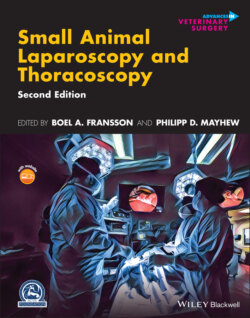Читать книгу Small Animal Laparoscopy and Thoracoscopy - Группа авторов - Страница 150
Instrumentation
ОглавлениеConventional multiport laparoscopy is governed by the rule of triangulation such that a view is established in tandem with the simultaneously working extension of the human hand by means of the instruments [3]. Because the single‐port platform follows the premise that all instruments enter the abdomen at the same site, one is forced to challenge the laws of traditional instrument triangulation. The single‐port platform creates significant physical and ergonomic constraints that make traditional procedures more difficult to learn and perform compared with traditional laparoscopic surgery. The proximity and parallel trajectory of the telescope and operating instruments placed through the single‐site led to the inevitable instrument and cannula collision, which ultimately interferes with smooth movements and makes the procedure more demanding than standard multiport laparoscopy.
Figure 6.8 The wound retractor in figure 11 can be used with a laparoscopic cap for insufflation
Source: Courtesy Boel Fransson Washington State University.
In trying to overcome some of the technical difficulties associated with single‐port surgery, bent and articulating instruments have been developed to reproduce the triangulation that is experienced with conventional multiport laparoscopy and to limit some of the stated difficulties associated with using standard rigid instrumentation in single‐port surgery [29].
However, it should be noted that single‐port surgery could successfully be performed using rigid instrumentation. An extensive body of literature exists describing single‐port procedures completed by means of standard rigid laparoscopic instruments in both humans and veterinary patients. An array of articulating and double pre‐bent laparoscopic instruments have been developed and marketed specifically for the single‐port platform in an effort to correct the difficulties resulting from the loss of triangulation. Bent or coaxial deviating instruments are in a fixed position and were designed to be offset from the straight axis of a standard instrument, enabling the surgeon to have internal and external working space [65–70]. The curved design provides acceptable intracorporeal triangulation and good ergonomic positioning for the hands (Figure 6.9). The articulating instruments have a design that mimics the movements of a surgeon's wrist and have a distal tip that can deflect relative to their shaft, offering seven degrees of freedom of movement [3]. Many of these instruments also offer axial 360° rotation for tip orientation similar to conventional rigid instruments. All of the articulating instruments can be introduced in both single‐port devices and conventional rigid trocar–cannula assemblies. The double pre‐bent instruments are intended to mimic triangulation through a curved design of both ends of the instrument shaft, which leads to antipodal directions of the tips and handles when the instruments are held in parallel [71]. The double‐bent instruments can only be used with soft, flexible, or specifically designed entry devices for bent instruments because the bends in these instruments prevent their introduction into a rigid trocar–cannula assembly.
Figure 6.9 Coaxial instruments used through single‐port devices can obviate some of the disadvantages encountered when the ability to triangulate is compromised.
Source: Courtesy of J. Brad Case.
Figure 6.10 A right‐angle adaptor placed onto the connection between the light cable and telescope can reduce interference between the light cable and instruments during single‐port surgery.
